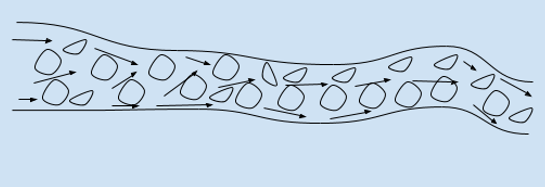This set of Irrigation Engineering Multiple Choice Questions & Answers (MCQs) focuses on “Classification of Rivers”.
1. Depending on the topography of the river basin, into how many classifications the river reaches are divided?
a) 3
b) 4
c) 5
d) 1
View Answer
Explanation: The classifications given on the basis of topography of river reaches are river in hills (upper reaches), rivers in plains (lower reaches), and tidal rivers.
2. The rivers in hills are further classified into how many groups?
a) 4
b) 2
c) 3
d) 6
View Answer
Explanation: Before entering the plains the upper reaches of the rivers flow through the hills, hence the name river in hills. These are further subdivided into a rocky river stage, and boulder river stage.
3. Which stage of the river is formed by erosion?
a) Aggrading
b) Tidal Rivers
c) Boulder River Stage
d) Rocky River Stage
View Answer
Explanation: In this type of stage of the river the flow is formed by rapid erosion. These river reaches have high steep with swift flow, and form rapids along their courses. The bed load carried by these reaches cannot be determined by usual bed load transportation formulas.
4. What type of river stage widens the bed?
a) Degrading
b) Incised River Stage
c) Boulder River Stage
d) Stable Type
View Answer
Explanation: The river bed in these reaches is created by itself, consists a mixture of boulders, gravels, shingles, and alluvial sand deposits. In latter stage, the river flows through deep well defined beds and wider floodplains. Here the river flows in a straight course. Due to the floods, the boulders and material travels downward and gets deposited there after floods. Because of the opposition to the flow due to these obstructions the river takes new course and thus widens the river bed.
5. In what reaches the river flows in a zigzag manner?
a) Boulder River Stage
b) Lower Reaches
c) Degrading
d) Tidal Rivers
View Answer
Explanation: The chief character of the river in these reaches is that it flows in a zigzag manner called meandering. This meandering is due to the difference in carrying the sediment which is similar to the bed load from one bank to the other bank of the river.
6. Into how many groups the rivers in floodplains can further be divided?
a) 5
b) 6
c) 4
d) 3
View Answer
Explanation: River in the floodplains is further divided into aggrading, degrading, stable, braided, and deltaic types.
7. In the meandering process on which side of the bank erosion takes place?
a) Convex Side
b) Bottom of the River
c) Concave Side
d) Due to Sediment Load
View Answer
Explanation: In these reaches there is a constant erosion of the river bed on the concave side and the deposition of the eroded soil on the convex side of the successive bends or between two successive bends.
8. In which type of river building up of slope is present?
a) Deltaic
b) Stable type
c) Degrading Type
d) Aggrading Type
View Answer
Explanation: This type of river is formed due to the silting action which increases the bed slope. This silting action is due to various factors like heavy sediment load, construction of obstructions like dam or a weir, and sudden intrusion from a tributary.
9. In which type of river there is a reduction of the available slope?
a) Braided
b) Stable Type
c) Aggrading Type
d) Degrading Type
View Answer
Explanation: This type of river is formed due to the constant erosion to reduce and finally dissipate available excess land scape. It is found below a dam or weir or barrage or above a cut off.
10. What type of river does the diagram represent?

a) Braided River
b) Aggrading Type River
c) Degrading type River
d) Stable Type River
View Answer
Explanation: This is braided river as the flow is around alluvial islands. These islands are developed due deposition of coarser material which cannot be transported under the existing conditions of the flow, consisting of coarse and fine material.
11. A river before joining the sea or ocean gets divided into branches.
a) False
b) True
View Answer
Explanation: As a river approaches the sea or ocean, the velocity of the flow gets reduced, and in turn silting action takes place resulting in rising of water levels and the formation of new channels. These channels or branches multiply in numbers as the river approaches the sea or ocean.
12. A river which does not change its alignment, slope is called a stable river.
a) True
b) False
View Answer
Explanation: In this type of river changes like silting action, scouring etc in alignment or slope occurs, but these changes are negligible may fail to produce any changes in the regime of the channel. In this type most of the sediment is brought to the sea or ocean.
Sanfoundry Global Education & Learning Series – Irrigation Engineering.
To practice all areas of Irrigation Engineering, here is complete set of 1000+ Multiple Choice Questions and Answers.
If you find a mistake in question / option / answer, kindly take a screenshot and email to [email protected]
- Apply for Civil Engineering Internship
- Check Civil Engineering Books
- Check Agricultural Engineering Books
- Practice Agricultural Engineering MCQs
- Check Irrigation Engineering Books
